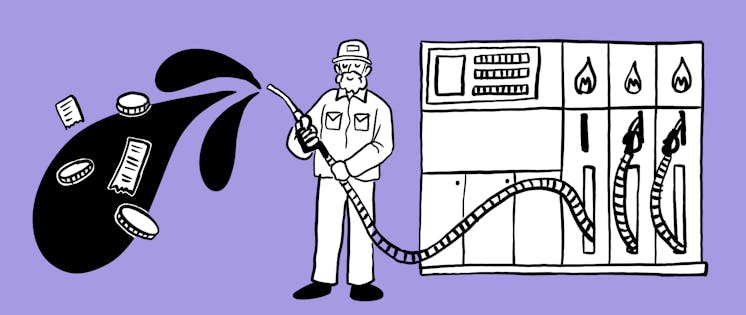
Standard rate VAT: How the cookie crumbles in the UK
The prospect of not paying the right amount of VAT keeping you up at night? The difference between the standard rate VAT and the reduced rate VAT making you more bamboozled than ever?
We’ve got you covered.
Let’s take a deep dive into the ocean of VAT in the UK from examples of standard rate VAT items to exploring the differences in the Irish standard VAT rate.
What is VAT and how does it work?
The concept of VAT itself is simple enough: Every time you sell an item or service you must charge a little extra on behalf of the government, collect it and send it to them each quarter.
In fact VAT itself stands for Value Added Tax. As in, every time an item or service gains value the government want tax from it.
But there are lots of different rules and regulations around VAT, like only businesses and sole traders who have a taxable turnover over £85,000 a year needing to register for VAT.
Another of those rules and regulations is described as the standard rate of VAT.
What is the standard rate VAT?
The standard rate VAT is the percentage of an item or service that you need to add on for VAT. In the UK the standard rate of VAT is currently 20%.
So if I was a VAT registered company, with a taxable turnover above £85,000, selling a watch for £100 then the standard rate of VAT on that watch would be £20. So I’d actually charge my customers £120 for that watch, keep £20 in reserve and send it to the government when I did my next VAT return.
It’s a way for the government to collect extra tax on certain items or services.
Though Northern Ireland follows UK VAT conventions, Ireland itself follows the Irish standard VAT rate of 23%. Ireland also has multiple tiers VAT at different rates to the UK so it’s worth checking Irish VAT regulations in full if it affects your business.
How did the UK VAT standard rate develop?
VAT in the UK replaced an old tax system called Purchase Tax in the 1970s. VAT focuses on taxing goods and services at every point along the supply chain, whereas Purchase Tax focused on taxing items when they were sold to the final consumer.
Though the standard VAT rate is currently 20% rates can change. VAT was only 10% of the value of an item when it was first introduced, but it continue to rise and fall based on government policy and the needs of the economy.
Year | Standard VAT rate |
|---|---|
1973-1974 | 10% |
1974-1979 | 8% |
1979-1991 | 15% |
1991-2008 | 17.5% |
2008-2009 | 15% |
2009-2011 | 17.5% |
2011- today | 20% |
The most recent change to the standard rate VAT in the UK was in 2011 when it was raised from 17.5% to 20% in an effort to bring down the UK’s high budget deficit.
As VAT only affects certain industries and goods it was stated to be a more “progressive” move by the chancellor at the time, George Osborne, than increasing other kinds of tax like National Insurance that would affect everyone equally.
What goods and services fall under the standard rate VAT?
The list of goods and services that fall under the standard rate VAT is described in extensive detail on HMRC’s website.
Examples of standard-rated vat items include:
- Alcoholic drinks
- Confectionery
- Crisps
- Sports drinks
- Hot takeaways
- Ice cream
- Soft drinks
- Mineral water
- Flowers and seeds
- Most clothing intended for adults
Remember it’s not just what you’re selling that decides whether or not you must charge VAT. You also have to consider whether:
- You are registered for VAT
- Who you’re selling to, for example some charities are eligible for reduced VAT
- How you have presenting your items or goods for sale
- It’s within the scope of the UK VAT system
As well as a myriad of other factors. So it’s worth looking at HMRC’s full list of VAT notices for a full list of examples of standard rated vat items industry and clarifying exactly what VAT rate you need to charge.
What’s the difference between the standard rate, reduced rate, zero rate and exempt VAT?
The government charges different rates of VAT for difference goods and services.
Some goods, such as children’s car seats, and some services, like home energy supply, can apply for the reduced rate of VAT that’s currently 5%. This makes those items and services cheaper for the consumer.
The zero rate of VAT is exactly that: You charge and record 0% VAT on anything you sell. But it still allows businesses to register for VAT themselves and claim back VAT they’ve paid on things to run their business.
This differs from being exempt from VAT where you do not have to charge VAT, but you also cannot register or reclaim any VAT you pay.
Rate of VAT | What percentage is it? | Can you reclaim your VAT? |
|---|---|---|
Standard rate | 20% | Yes |
Reduced rate | 5% | Yes |
Zero Rate | 0% | Yes |
Exempt | N/A | No |
How does the standard rate of VAT work in accounting and reclaims?
With the standard rate of VAT you must pay the government from the moment you’ve invoiced a customer. This means sometimes you’re liable to pay HMRC for money you haven’t received yet.
VAT management is an important part of cash flow for small businesses, freelancers or any business that doesn’t hold lots of cash in reserve.
Bear in mind standard VAT accounting also means you can reclaim VAT from the moment another business invoices you. Which also massively affects cash flow across a business.
You don’t have to use standard VAT accounting methods if it doesn’t work for your business, as there are a range of options like cash accounting or annual VAT accounting.
Read our article on VAT accounting to decide which works best for your business.
Pleo can help you keep track of your VAT
Our automated invoice software keeps helps you retain all the evidence you need to pay VAT or show that you’ve accurately reversed it. You can even integrate it with your accounting system of choice, from Sage to Quickbooks.
Pretty cool? We think so too.
Try automating your invoices with Pleo today.

Smarter spending for your business
Save time on tedious admin and make smarter business decisions for the future. Join Pleo today.
Powered in the UK by B4B partnership
You might enjoy...
.png?ixlib=gatsbyFP&auto=compress%2Cformat&fit=max&dpr=2&w=373)
The lowdown on professional subscriptions HMRC approves of in 2024
Find out which of your professional subscriptions HMRC approves of and how to get tax relief on them in 2024.

What businesses need to know about HMRC fuel rates for private cars in 2024
Businesses can offset fuel expenses for work-related journeys, but what about if you’re not driving a company car… can the fuel rates still...

What you need to know about HMRC uniform tax in the U.K. for 2024
Discover how you can turn time spent on washing your workwear into billable hours.
